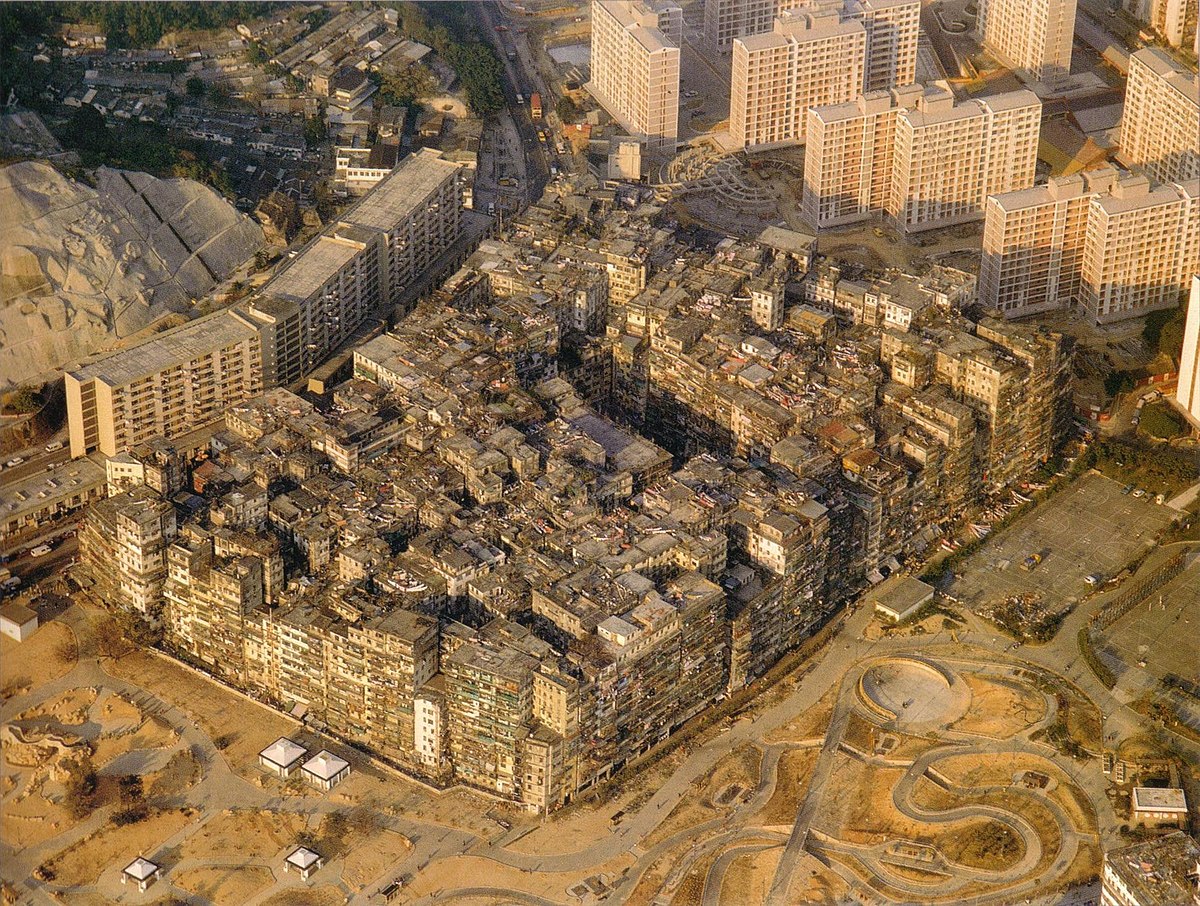
[Living in downtown Manhattan is rather like being in the Walled City of Kowloon]
The place where I live, specifically, the few blocks where I live in New York’s financial district, resembles the fabled Walled City of Kowloon having the highest population density in the world. It is known affectionately as ‘The Canyons’, on account of the combination of an 18th Century organic, narrow street pattern and 20th Century skyscrapers.
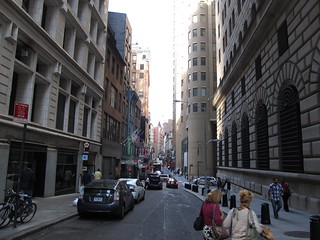
[The street where I live, in the canyons.]
During weekdays, every horizontal surface takes a beating that compares to a continuous exodus from a stadium event. Road surfaces are a patchwork quilt of tarred repairs, near indestructible travertine slabs outside corporate HQs are cracked and worn and the Fulton St. subway looks like an abandoned ruin, on account of the fact that it is the exact opposite. Even the cookie-cut design of the Starbucks on the corner next to J & R shows signs of decay in the varnish that has worn from the floorboards, rendering it unlike the sanitized Starbucks elsewhere that are stamped from exactly the same mold.

[NYC subway during the boom times, when money was pouring into the city.]
What is at work is a perfect example of the physics of open systems and the unassailable second law of thermodynamics. This tells us that overall entropy or disorder always increases even when there is the semblance of localized order. Lower Manhattan, despite its cracked travertine, rats and roaches is that semblance of order. It is an open system, held far from equilibrium, and the net product of ordered buildings and disordered garbage vs. high order financial input is never a zero sum game. Money flows in to just about maintain the order of the buildings, and garbage flows out through a subterranean network of steaming ducts, pipes, and evil smelling trucks that clear the mounds of black bags, after dusk and disappear into parts of Queens that the denizens of Wall Street don’t know exist.
Like a living organism, Manhattan lives on the edge of chaos, a finely balanced system which requires constant input to prevent it falling apart. But because this system consumes at such a vast rate, it is an accelerated version of other urban areas. What might happen if the sustenance flow of cash stopped can be seen clearly where in other cities it would be invisible. The cracks in the travertine are chinks in New York’s armor clad buildings that give a glimpse of entropic decay and what would happen to everything if the money flow stopped.
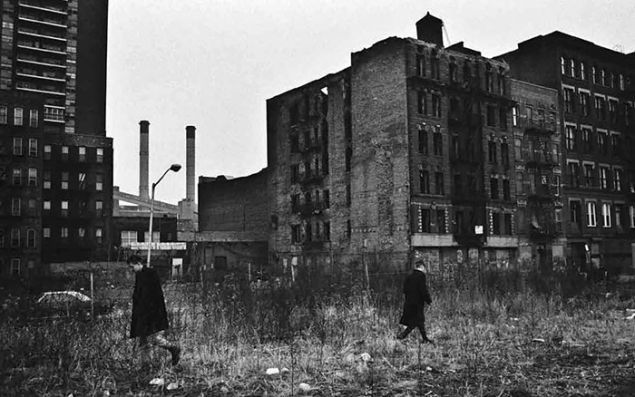
[To get some idea of how fast New York can change, this is Tomkins Square, the nexus of the East Village, a few years before Sex in the City and the Yuppification of much of Manhattan.]
Where the money flow comes from ultimately depends on a building at the end of our street, The New York Federal Reserve. This institution is housed in a copy of a Medici banker’s palace, complete with Florentine armor in the form of a rusticated base which is three times the size of an original. The fake 16th century style protective stone is a metaphor, the real strength of the Federal Reserve is in the mind of the people who put trust in it and over the last year, this confidence in a system dependent on a fiat currency with its abstract promise indicated by ones and zeros on flat screens and ink on dollar bills has disintegrated.

[The NY Federal Reserve is housed in an oversized copy of a Florentine palace.]
Despite the implosion of the corporations around Wall Street, from prime brokerage to sub-prime insurance, the buildings look much the same, and superficially, so do the people. On the principal day of the 2008 crash, I went to the gym on the corner of Broad and Wall Street and unlike the pictures in newspapers of bankers in distress the only abnormal sight was someone dressed in a bear costume with a semi-bare woman on each arm. There were no people jumping out of windows and no visible signs of despair.
It takes a while for people and buildings to fall apart. The difference for Manhattan is that its density requires a huge input of money to keep it from decaying more quickly than other towns and it relies on a disproportionately large percentage of that money coming directly from banking.
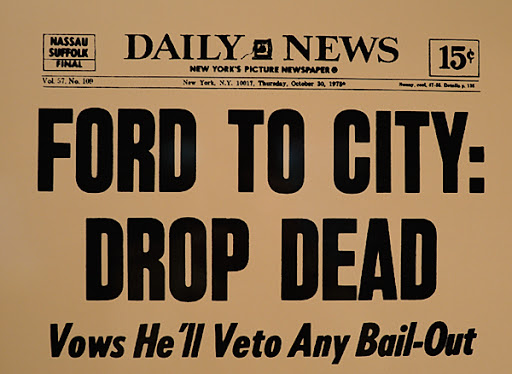

New York is a city which decays fast and has been dependent on the very source of funds which has been worst hit by this recession. In addition, there is a precedent for what happens when cash dries up in New York: the 70s. Crime rose to mythical levels, wealth retreated to a small enclave on the Upper East Side and a million people left the city for the suburbs. But after a decade of decay, it bounced back largely because, despite the squalor, people crave culture and excitement and the chance interaction with other people that cities offer.

[The suburbs weren’t all bad…apart from the commute.]
One of the principal reasons for the reverse migration back into cities was the emergence of a creative class who colonized the light industrial financial district hinterland of cities like New York and London. This breathed life into virtually derelict downtown areas stitching fragmented districts together to recreate civic coherence and providing the catalyst for overall urban renewal. This process was made possible because the once toxic light industrial activity of things like printing was replaced by things such as computer based graphic design and desktop publishing where people could live and work in the same industrial buildings without health risks.
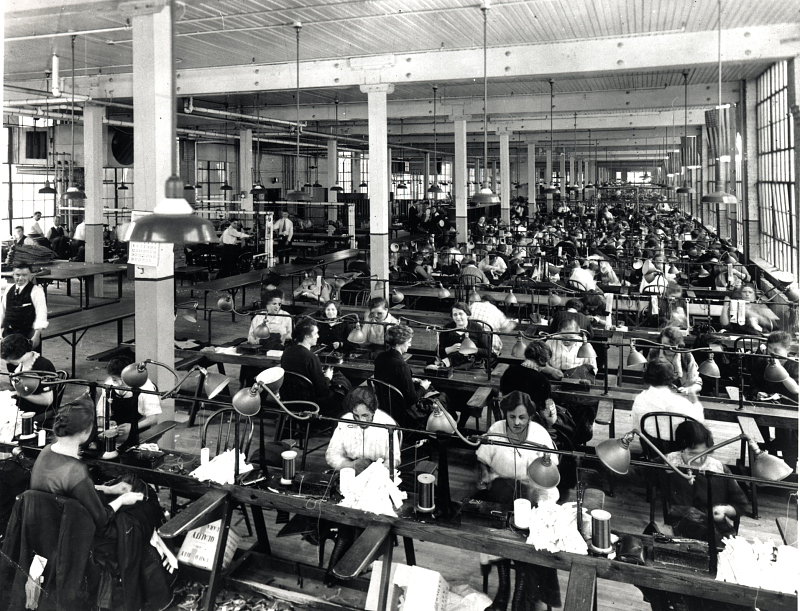
[ …what those lofts looked like before Andy Warhol and Quark Express.]
Areas such as London’s Dickensian East End haunts of Jack the Ripper became home to large numbers of young creative people. London’s Shoreditch and Whitechapel contained the highest concentration of artists per square mile, in Europe, until they moved on to cheaper places such as Berlin, leaving condos fabricated in the style of fake lofts for financial services employees who worked nearby. In the early 90s, in London a 3 floor warehouse could be purchased in Shoreditch for less than 100,000 dollars and lived in illegally until it was rezoned as live/work. At the peak, a year ago, these buildings were worth millions. This followed the pattern of New York, where loft living originated in the robust, flexible, high-ceilinged 19th Century warehouses of Soho and Tribeca. Although industrial, these buildings were of high quality, with classical cast iron columns and the solid over-specified construction required to support heavy machinery.
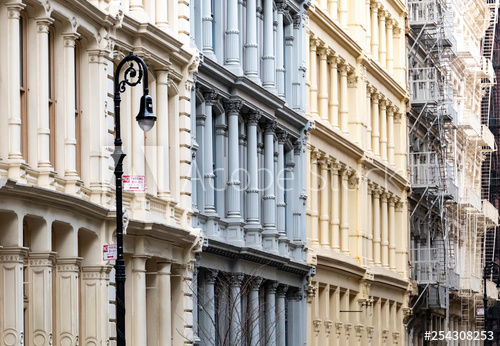
[The mass production of classical motifs meant that there are more classical columns in downtown New York than were made by both the ancient Greeks and Romans combined.]
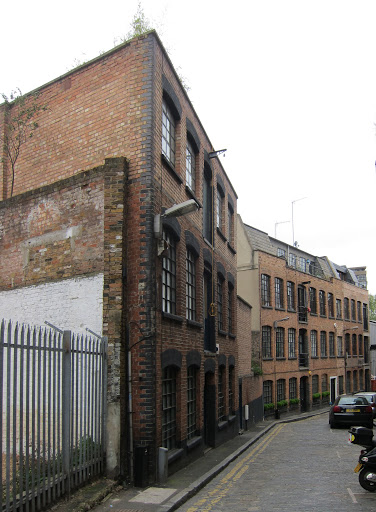
[A 3 floor warehouse like this in Shoreditch cost less than 100,000 dollars 15 years ago (I know because I bought this building in 1992 for 42,000 pounds – and sold it, unfortunately.)]
Today there are other places with decent architecture that have been overlooked and are now possible to live and work in. These places are not in cities and they are now habitable for city types because of the Internet and mini hub, point-to-point transportation such as low cost airlines. Like desktop publishing which allowed people to live and work in former printer’s workshops, the Internet allows people to live in attractive rural areas and still work with colleagues in major cities. The special criteria for these rural areas are broadband access and low cost direct transport such as EasyJet, Jet Blue or reliable rail networks.

[Where I am writing this – cheaper than a 1 bed condo in Manhattan]
Although I live in New York, I am writing this from a house in a village in the south of France. I have a meeting in London next Monday, and I will be able to get there before lunch and for less than 100 dollars on a low cost airline from a small local airport. Business contacts do not know that I am not in New York and I can receive calls and correspond with people as if I am there. But I can also go to the beach, and sit in the sun, in January. And I can do this without being rich enough to afford a quality of life remotely comparable to this in a city.
With 147 dollar oil, the suburbs faced extinction. Six months later, without Wall Street, New York faces a possible return to the 70s. Somewhere between those twin threats of rising crime and squalor and expensive and lengthy daily commuting exists an alternative. The areas that comprise this alternative have sense of place since they have developed organically rather than in the hands of a developer, and they are cheaper than suburbs since they are too far for a daily commute by car. Tethered to the Internet, they offer a way of living balances the quality of life that space and access to nature provides coupled with contact with cities on either a daily, virtual basis (via the Internet) or occasional but real basis (via transportation mini hubs). Welcome to exurbania.
[…] time hating anyone … of you is none of your business. 30. Time heals almost everything What comes after lofts and the suburbs? – davidgalbraith.org 01/28/2009 The place where I live, specifically, the few blocks where I live […]
What a great post. I’ve been thinking personally along these same lines. As a web worker, I’m not bound to anywhere. I grew up in the burbs (more or less) and live in the city now, but I’m considering a move to somewhere “else”. Southern France sounds pretty nice… I think there’s a pull away from the rat race but an unwillingness to enter the bland of the suburbs. People want to be cultured but calm.
I think there will be a great spreading out of intellectuals to all those locations that have an idyllic quality but are remote, the opposite of cities that grew when being close to the shipping docks was mandatory. So I imagine steady growth will happen in places like Madison, WI, Portland, OR, college towns, Cape Cod, Louisville, etc.
Thats a good point about college towns, since they provide intellectual fulfillment without the self emergent, bookish, critical mass of bigger cities.
I used to think this, and i moved to a college town from new york. Well, life is certainly easier. But it’s boring! There are some intellectuals here, but not enough. Problem is, odds are not good that the 10-100 cool people in your new town will be perfect friends for you. And that’s not a big enough community to create many events or things worth participating in. Plus, your property is cheap and will stay cheap, not as good an investment as in new york.
Also, there really are very few people who can work from home with little need for contact with clients etc. You end up living cheaply but spending a lot of money on traveling and eating out because there is nothing else to do.
Well, just my 2 cents, I’m moving to Brooklyn.
Love it. 🙂
[…] Essays: Information and Evolution | What Comes After Lofts and the Suburbs | The Joe Ades Myth Deconstructed | Goodbye Dubai (on […]
[…] What comes after lofts and the suburbs? Read all posts tagged: living | » […]